Croft All-Malt: 1940
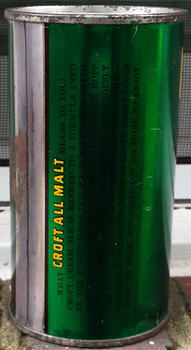 |
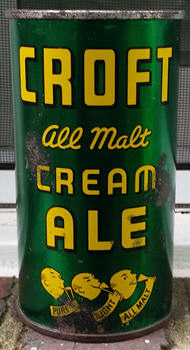 |
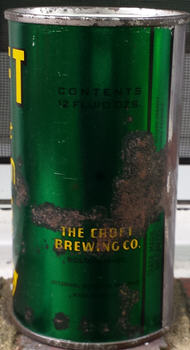 |
I covered Croft exactly ten years ago, in July 2004. This time I want to show a related label, Croft "All Malt" Beer. What the heck is "All Malt" and how does it fit into the history of beer in the US?
All Malt
Basically beer has four main ingredients.
1. Water. That's most of it. According to some Australian and European drinkers, that's all American beer is, at least the major brands.
2. Grain, most commonly malted barley.
3. Hops: to add bite and flavor.
4. Yeast.
The grain is the key part for what I want to show this month. Barley is the most commonly used in beer, although there are varieties that use other grains. This is where the "Malt" part come sin.
Malt
Malt is created by germinating cereal grains. The cereal grains are soaked in water until they begin to germinate, then are dried with hot air to stop further germinating. This process develops the enzymes needed to modify the grain's starches into sugars, and it breaks down proteins so that they can be used by yeasts. Brewers often had their own malting rooms, usually on the top stories of the brewery, allowing the malt to be easily moved down to the next brewery level for the next step in brewing.
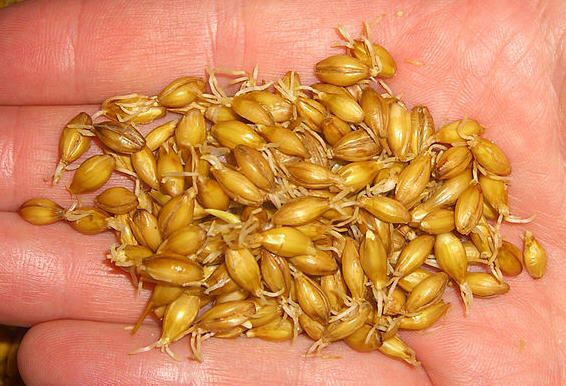 |
Malted barley, note the white sprouts. Photo from Wikipedia. "Grünmalz" by Peter Schill - Self-photographed. Licensed under Creative Commons Attribution-Share Alike 2.0-de via Wikimedia Commons - |
OK, so what does that have to do with "All Malt" beer? For that we need to go back to the pre-Prohibition period and the growth of national brewers such as Schlitz, Pabst, and Anheuser-Busch.
Adjuncts and Shipping
In the late 19th century some of the biggest breweries in the US became "shipping breweries." They shipped their beer in barrels or in bottles, to distant cities. If they sent it in barrels, it was often bottled at the destination by a local bottler. That was cheaper than sending bottles, which were heavy and breakable. However, that also meant that the brewer was dependent upon a local bottler, often a contractor, to handle the beer, which meant a lack of quality control for the producer. If John's Bottling Company mishandled the brewery's beer, then it was the brewery's reputation that suffered.
Sending beer a long distance had its hazard anyway. Beer could be spoiled by sitting in a hot boxcar, so shippers had to find ways to keep it cool. As a result, brewers were among the early users of refrigerated boxcars, which were cooled with ice at first. The brewers would copy how the meat companies operated and set up ice houses along the railroad to refresh the ice as the train went along.
Even kept cool, time and distance were not beer's friends, but the breweries discovered that it they used adjuncts such as corn or rice, then the beer would last longer. So they began to use other grains along with barley. To more traditional brewers this was heresy. They accused the big brewers of using cheaper ingredients, which cheated their customers. There was some truth to this, they were using cheaper ingredients. Whether the beer was better or worse with adjuncts added seemed to be a matter of taste.
This was an issue for those fighting for pure food and drug laws. Upton Sinclair's 1906 novel, "The Jungle" graphically illustrated the disgusting conditions that existed in Chicago's meat-packing plant. However, there was pressure on industries as well, including brewing, to reveal what chemicals and ingredients they used in their products.
Beginning in 1884 the Department of Agriculture began to run a long series of tests for adulterants on foods, condiments, spices, and beverages. Earlier tests had shown contaminants such as lead in products such as butter, oleomargarine, alcoholic beverages and coffee berries. The series of tests beginning in 1884 were supervised by Agriculture Department chemist Dr. Harvey Wiley, an Indiana native (Hanover College graduate) and Civil War veteran who was concerned not just with harmful additions such as lead, but with consumer fraud by manufacturers substituting cheaper ingredients without their customers knowing. Such adulteration, he believed, put honest competitors at a disadvantage.
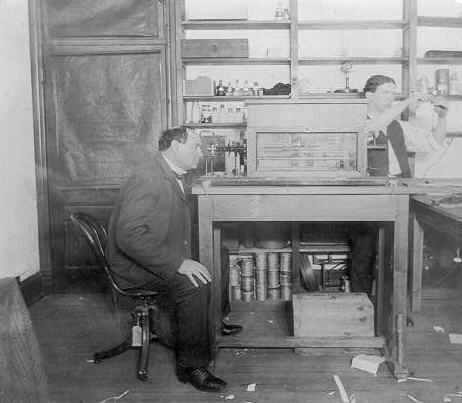 |
"Harvey Washington Wiley, looking through optical instrument in laboratory at the U.S. Department of Agriculture Bureau of Chemistry" 1902. Library of Congress, LC-USZ62-96397 |
The series of reports, published as parts of “Bulletin 13: Foods and Food Adulterants” by the Department of Agriculture, began to come out in 1887. Each bulletin listed the “normal characteristics of the product” being tested, then gave the specifics of how each was tested. Products came from elsewhere in the US, but many were simply purchased by the government chemists themselves in the markets in Washington. They included local products, but also those from national companies, such as the shipping brewers.
The first three part of the Bulletin were issued in 1887, others would soon follow. These first reports covered dairy products, spices and condiments and, in Part III, “Fermented Alcoholic Beverages, Malt Liquors, Wine and Cider.” The reports were not as horrific as one might have feared, although some were still disturbing. Milk was most commonly adulterated by removing cream and by watering it down. Oleomargarine was sold as real butter, but this was not a health issue. Spices were more of a problem, especially in ground form. Some “pepper” did not actually contain much actual pepper and had been stretched with rice, corn, mustard hulls even plain old dirt. The alcohol report indicated that American wines were often watered down, and in many cases did not have much actual grape in them, consisting largely of alcohol, sugar and water.
What about the beer? The report tested thirty-two different beers, in bottles and draft, "all the different brands and varieties of beers of domestic manufacture obtainable in Washington.” They included "the various popular brands made in Milwaukee, Cincinnati, Philadelphia, New York, &c., which are sold all over the country, as well as the product of the few local [DC] brewers. Some were obtained from wholesale dealers, but the majority were purchased in retail saloons and groceries, without statement of the purpose for which they were intended. All the draft beers were obtained in this way."
The report announced that some of the beers used other materials as substitutes for malt, such as sugar, which added no nutritional value. The possible additives of most concern, however, were preserving agents used to keep the beer from spoiling during shipping.
The US Congress as well as several state legislatures, began considering "Pure Beer" laws.Some of the proposed bills would have either banned adjuncts, or required them to be specifically labeled. The big breweries were obviously concerned and managed to lobby Congress and the states enough to stop these types of restrictions. Many smaller, local breweries did want such laws passed, as it would have given their products a boost. When the suggested regulations failed, the smaller breweries were left with the option of boasting that their beers were "All Malt" or "pure" with no additives. This month's can came decades after the Pure Food issue was at its height, but it is a result of the lingering effects of the shipping breweries' adding adjuncts to their beer and the reaction to it.
Note, "All Malt" is different from "Malt Liquor" which is a stronger beer, but does not necessarily contain only malted barley.
Some All Malt Beers
A number of breweries tried selling an All-Malt Beer in cans between 1935 and 1965. This short list shows the ones I could find.
Croft All Malt Cream Ale (Croft Brewing)
Genesee All Malt Beer (Genesee Brewing)
Malt Marrow "The Pure Malt Beer" (Best Brewing)
Trommer's Malt Beer (John F. Trommer, Inc)
This is not a complete list. It only includes breweries that canned their beer, and those brands that bragged about being only malt in their names. Of the four, two (Croft and Genesee) are pre-war. Malt Marrow is from the 1950s. Trommers seems to have lasted the longest, as it appeared in cans before and after World War II, but it still seems to have been discontinued, at least in cans, before 1950. The limited number of examples seems to indicate that All Malt was not a big selling point at the time.
Sources
Some of this month's COM come from my book research on Christian Heurich.
